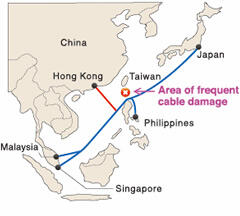Microsoft ends support for Internet Explorer on June 16, 2022.
We recommend using one of the browsers listed below.
- Microsoft Edge(Latest version)
- Mozilla Firefox(Latest version)
- Google Chrome(Latest version)
- Apple Safari(Latest version)
Please contact your browser provider for download and installation instructions.
Field Report
Fiscal 2024
Hyuga-nada Earthquake (Issuance of Nankai Trough Earthquake Extra Information)
On August 8 at 4:42 p.m., a magnitude 7.1 earthquake occurred with its epicenter in the Hyuga-nada Sea. This was the first issuance of Nankai Trough Earthquake Extra Information. NTT Group had taken measures to prepare for a Nankai Trough earthquake by conducting emergency inspections of disaster recovery equipment. This allowed it to secure critical communications, especially in disaster-affected areas, and provide relief to disaster victims.
Typhoon ShanShan (No. 10) of 2024
Typhoon No. 10 originated in the Mariana Islands at 3:00 a.m. on August 22 and moved northward , becoming extremely powerful on August 27, approached the Amami Islands, and made landfall near Satsumasendai City, Kagoshima Prefecture on August 29. NTT Group mobilized recovery equipment and personnel in advance of the approach of the typhoon to prepare for prompt restoration. After the typhoon passed, NTT Group provided wide-area relief assistance from various areas, including eastern Japan, and worked to secure critical communications, especially in disaster-affected areas, and support disaster victims.
-
-
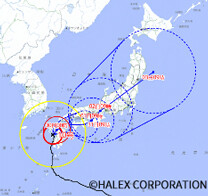 Track of Typhoon No. 10
Track of Typhoon No. 10
(As of August 29, 2024, 1:00 PM) -
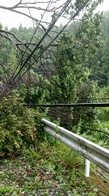 Damage to telecommunications
Damage to telecommunications
equipment caused by fallen trees
-
-
-
 Connecting emergency power
Connecting emergency power
to telecommunications building -
 Arrival of disaster recovery
Arrival of disaster recovery
vehicles from various locations
-
Heavy rain from September 20, 2024
Heavy rain with thunderstorms occurred over a wide area due to extremely unstable atmospheric conditions caused by the inflow of hot and humid air into a stagnant front near the Sea of Japan and the Tohoku region of Japan. The Noto region of Ishikawa Prefecture in particular experienced record-breaking heavy rainfall, resulting in the issuance of a special heavy rainfall warning, due to the formation of a linear precipitation zone. The heavy rainfall created numerous landslides and caused damage to many of NTT Group's telecommunication facilities. NTT Group worked to quickly restore services and provide relief to flood victims through the use of satellite communications equipment such as Starlink.
-
-
 Mobile base station
Mobile base station
damaged by landslide -
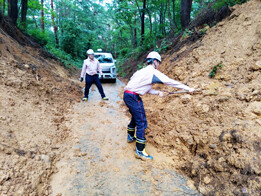 Clearing roads for
Clearing roads for
disaster recovery vehicles
-
-
-
 Service restoration using
Service restoration using
satellite communication equipment -
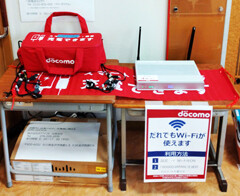 Free charging and Wifi service
Free charging and Wifi service
at an evacuation shelter
-
Fiscal 2023
The 2024 (R6) Noto Peninsula Earthquake
In the vicinity of the Noto Peninsula, large-scale power outages coupled with the cutting off of roads due to landslides and so forth and areas that were difficult to access arose in great number as a result of the earthquake (maximum seismic intensity: 7) that occurred in the Noto Region of Ishikawa Prefecture on January 1. In turn, communications equipment providing telephone and Internet service, both landline and mobile, took massive damage. In the face of this, we pushed forward with the recovery of communications services largely through the maintenance of power at communications equipment and the utilization of satellite communications and shipboard base stations, and endeavored to secure vital communications and communications in afflicted areas and provide support to victims.
-
-
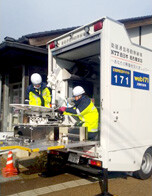 Provision of public telephones
Provision of public telephones
for use in times of disaster
through portable satellites -
 Transport and aerial photography using helicopters
Transport and aerial photography using helicopters
-
-
-
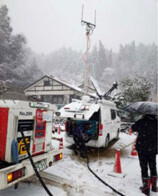 Securing of power sources for
Securing of power sources for
mobile base station trucks -
 Operation of shipboard base stations
Operation of shipboard base stations
-
Typhoon Khanun (No.6) of 2023
Over an extended period of seven days between August 2-8. Typhoon Khanun lingered in the vicinity of the Okinawa and Amami regions, causing large numbers of power outages and strong winds that resulted in numerous cases of cable damage. At the NTT Building and mobile base station, in addition to endeavoring to maintain communications with the use of emergency power sources, we established a wide-area support network that included East Japan as well as the various areas of West Japan, and worked towards recovering equipment at an early stage.
-
-
 Track of Typhoon Khanun
Track of Typhoon Khanun
(As of August 7, 2023, 9:00 AM) -
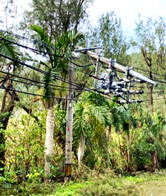 Damage to communications
Damage to communications
equipment
-
-
-
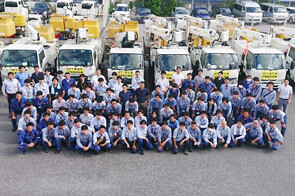 Scene of wide-area support
Scene of wide-area support
-
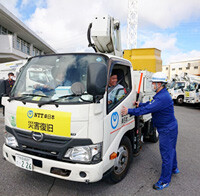 Mobilization of support team
Mobilization of support team
-
Fiscal 2022
Typhoon Nanmadol (No. 14) of 2022
Typhoon Nanmadol landed near Kagoshima City on September 18, resulting in gale-force winds over a wide range extending from western to northern Japan and centered on Kyushu. This also brought heavy rains, particularly in the Kyushu and Shikoku regions, and major damage occurred. The group worked as a team to recover from problems like utility pole and cable damage due to landslides, fallen trees, and so forth in various regions, through efforts such as wide-area support from NTT East to NTT West, and we worked hard to: provide vital communications relief via disaster response equipment, maintain power sources of communications equipment in the face of long-term power outages, and strengthen support for victims.
-
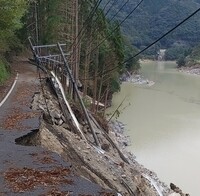 Communications equipment struck
Communications equipment struck
by landslides -
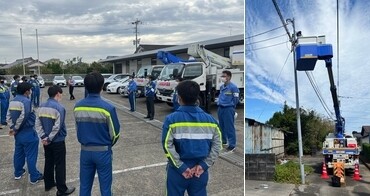 Recovery activities carried out by wide-area support teams
Recovery activities carried out by wide-area support teams
-
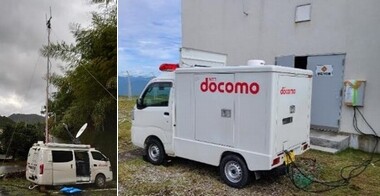 Recovery of services using mobile base station trucks and
Recovery of services using mobile base station trucks and
mobile power supply trucks
Fiscal 2021
Heavy rain from July 1, 2021 and heavy rain in August 2021
Damage occurred over a wide range, including Kyushu, Chugoku, Tokai, and Tohoku due to "heavy rain from July 1, 2021", when the seasonal rain front stagnated over the region from western to eastern Japan from the end of June to early July and there was heavy rain over a wide range, and "heavy rain in August 2021" where there was heavy rain over a wide range from western to eastern Japan due to greater activity of a front which stagnated near Japan. We recovered from problems like utility pole and cable damage due to landslides, fallen trees, and so forth in various regions, and worked hard to: provide vital communications relief via disaster response equipment, maintain power sources of communications equipment in the face of long-term power outages, and strengthen support for victims.
-
-
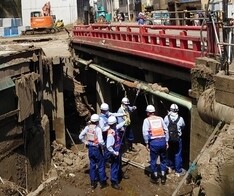 Survey of disaster effects at
Survey of disaster effects at
bridge sections due to mudflows -
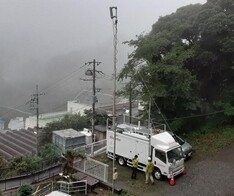 Securing communications using
Securing communications using
mobile base station trucks
-
-
-
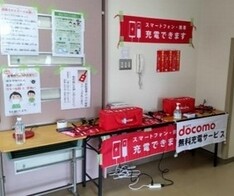 Free charging services for shelters, etc.
Free charging services for shelters, etc.
-
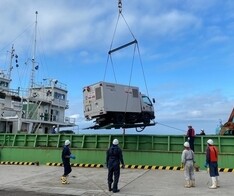 Transport by ship of
Transport by ship of
mobile power supply trucks
-
Fiscal 2020
The Heavy Rain of July 2020
In July 2020, a seasonal rain front which remained stationary for a prolonged period caused localized heavy rain in areas throughout Japan from July 3rd to the 31st. As a result, areas of Kyushu--especially Kumamoto Prefecture--and the Chubu region and other areas suffered severe damages. Recovery activities were undertaken to repair communication cables and telephone poles damaged by fallen trees and landslides. Additionally, disaster countermeasure equipment was used to restore essential communication services, and after blackouts lasting extended periods, efforts were made to strengthen the response to the needs of affected customers by preserving power supply for communication facilities.
-
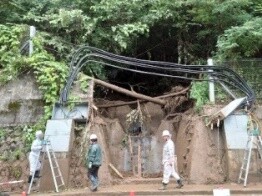 Emergency restoration using temporary
Emergency restoration using temporary
duct lines -
 Secured communications via portable satellite
Secured communications via portable satellite
entrance -
 Transporting generators and fuel together with Ground
Transporting generators and fuel together with Ground
Self-Defense Forces
Fiscal 2019
Typhoons Faxai (No. 15) of 2019 and Hagibis (No.19) of 2019
When Typhoon (No.15) "Faxai" came ashore on September 9th in central Chiba Prefecture, severe winds caused widespread damage, as did the heavy rains that covered a vast area in eastern Japan resulting from Typhoon (No.19) "Hagibis". Recovery activities were undertaken to repair communication cables and telephone poles damaged by fallen trees and landslides. Additionally, disaster countermeasure equipment was used to restore essential communication services, and after the widespread blackouts lasting for extended periods, efforts were made to strengthen the response respond to the needs of affected customers by preserving power supply for communication facilities.
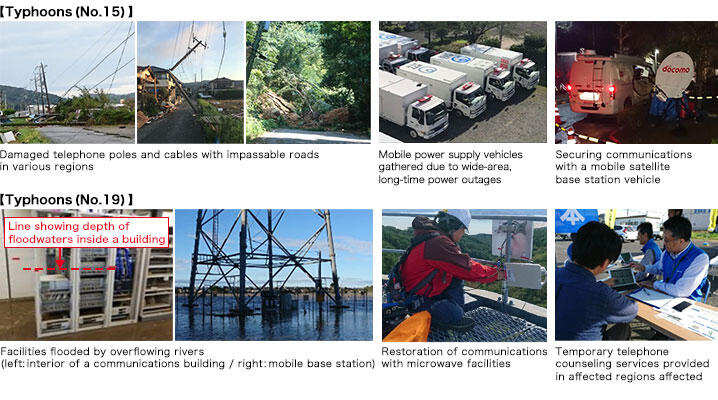
Fiscal 2018
The Heavy Rain of July, 2018
From June 28 through July 8, 2018, record-breaking heavy successive heavy downpours of rain resulting from weather fronts and Typhoon (No. 7) "Prapiroon" hit, centering in southwestern Japan. Recovery activities were undertaken to repair communication cables damaged by landslides and flooding rivers, and at the same time restoration of the communication services was carried out with anti-disaster measures equipment such as mobile entrance satellite base station vehicles.
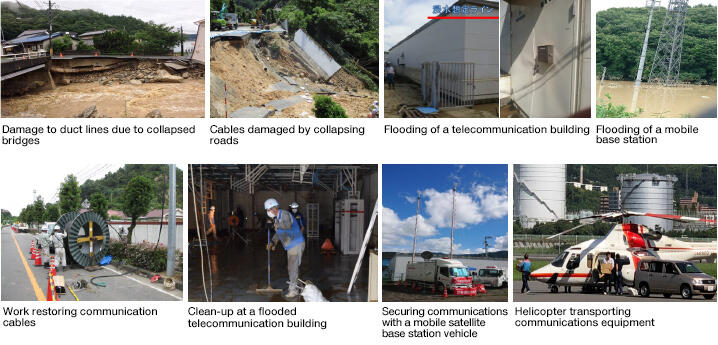
The 2018 Hokkaido Eastern Iburi Earthquake
On September 6th 2018, an earthquake with an intensity of 7 on the Japanese shindo scale hit Hokkaido at Atsuma-cho.Together with the restoration of the communication facilities which suffered damage from landslides, and wide support provided in response to power blackouts using mobile power supply vehicles. Additionally, the underwater cable-laying vessel - "Kizuna" was used to transport fuel, and etc.
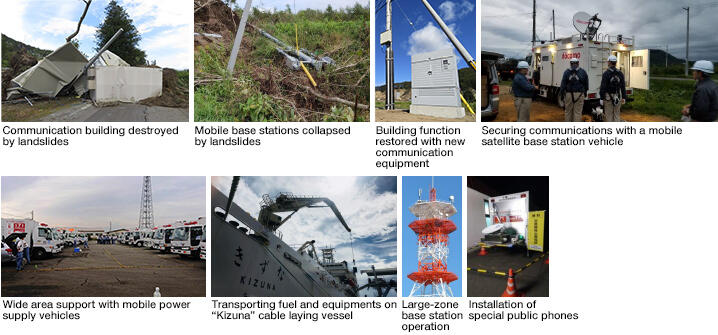
Fiscal 2017
We conducted restoration efforts in response to heavy rains in the northern area of Kyushu Island and after Typhoon "Talim" (Typhoon No. 18) in fiscal 2017. Despite landslides and power blackouts, we were able to secure essential communication lines, restore communication services, and provide support at evacuation shelters.
Heavy Rains in the Northern Area of Kyushu Island
On July 5th and 6th, 2017, the northern area of Kyushu Island was hit by record-breaking heavy rains.

Typhoon Talim (No. 18) of 2017
A typhoon which made landfall in Kagoshima Prefecture on September 17th, 2017, also resulted in heavy rains in the southwestern islands, in western Japan, and on Hokkaido Island.
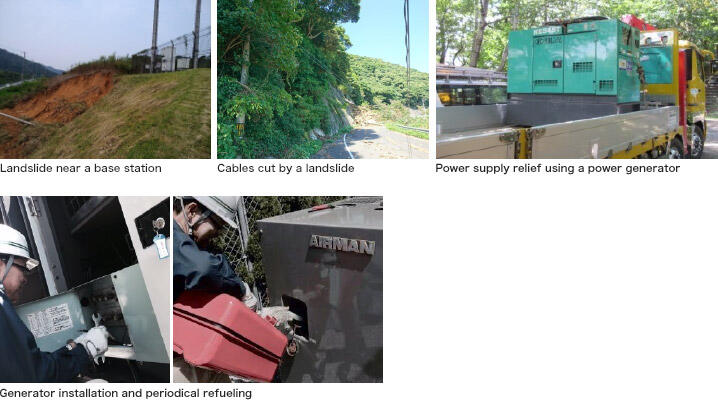
Fiscal 2016
The 2016 Kumamoto Earthquake
In April, 2016 two earthquakes each with a seismic intensity of 7 hit the Kumamoto district of Kumamoto Prefecture on the island of Kyushu.
Immediately after the disaster occurred, the NTT Group set about securing critical communications and the 110, 119 and 118 emergency call services and to restoring communication services. At the same time, emergency use public phones, free-of-charge Wi-Fi, and battery recharging service were provided. In addition, the NTT Group also offered support at evacuation shelters.
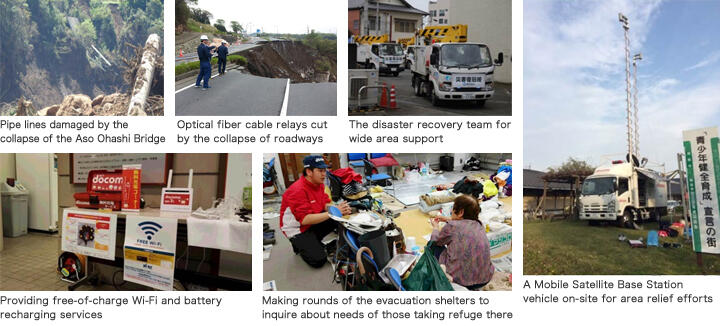
Typhoon Lionrock (No. 10) of 2016
After following an unprecedentedly unusual path, Typhoon "Lionrock" made landfall in Iwate Prefecture on August 30, 2016, causing severe damage in Hokkaido and Iwate Prefectures.
The NTT Group worked assiduously to restore the communication facilities devastated by river flooding and landslides, and to secure power supplies for the communications equipment affected by the commercial power blackout.
Using such equipment as multirotor drones contributed to a swift restoration of the communications equipment.
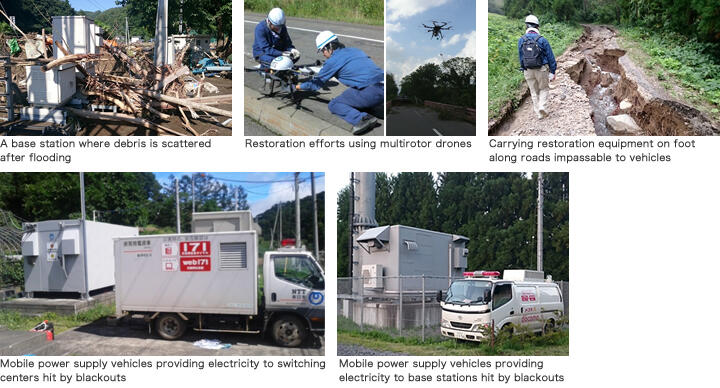
Fiscal 2015
Disaster measures activity for heavy rain, volcanic eruptions, etc.
There have increasingly been cases where communication facilities are hit by worse damage than had previously been assumed possible, caused by natural disasters such as heavy rain, volcanic eruptions, etc. In addition to taking measures during normal times, NTT group companies will carry out quick restoration activities of communication facilities and set up special public phones in shelters when damage occurs.
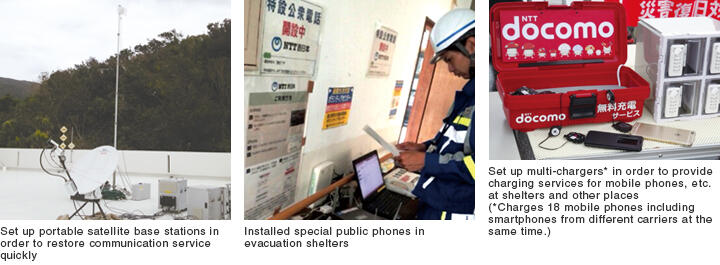
Fiscal 2013 , 2014
Mudslide damage caused by heavy typhoon rains
Heavy typhoon rains triggered mudslides on the island of Oshima (Tokyo) on October 16, 2013, and in the town of Nagiso in Nagano Prefecture on July 9, 2014, toppling telephone poles and severing communications cables. We strung temporary cables and took other steps to enable services to be restored promptly.
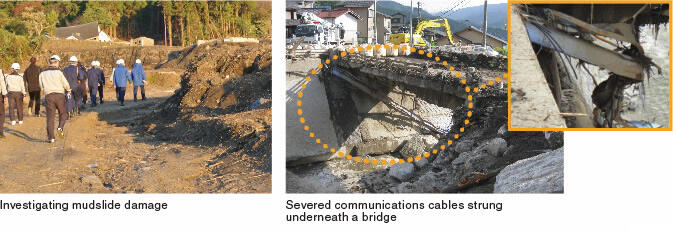
Snowstorm damage
In February 2014, parts of Japan suffered two heavy snowfalls in quick succession. The snowstorm of February 8 broke all previous records in the areas affected, with 27 cm of snow recorded even in the center of Tokyo. Communications services were severely affected by the heavy snow, but we used vehicle-mounted base stations and power supply vehicles to maintain services and secure communications in affected areas.
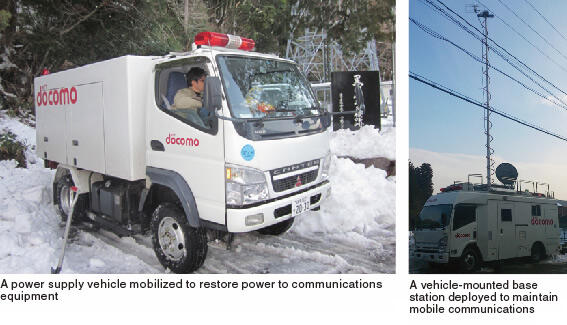
Fiscal 2012
In July 2012, communications services in northern Kyushu were seriously disrupted when heavy downpours caused large-scale landslides and destruction of roads and bridges, leading to extensive severance of communications cables and damage to telephone poles and other infrastructure.
Restoration of fixed lines
In locations in which trunk lines were severed as a result of damage to bridges, our field workers strung temporary cables above the bridges, and even carried heavy cables across mountainsides on their shoulders in mountainous areas that could not be accessed by vehicle. Prompt actions combined with the expertise and unstinting efforts of our field staff enabled the quick restoration of fixed line services in the area.
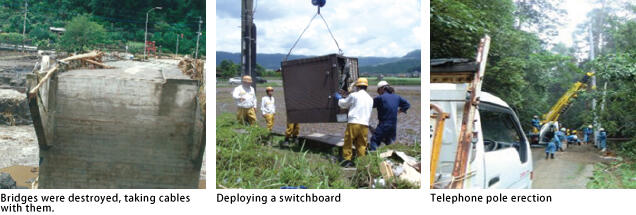
Restoration of mobile phone services
Mobile phone services were disrupted by wide-area power outages and the severance of communications cables. We used mobile base stations and portable satellite entrance base stations to restore services.

Fiscal 2011
Typhoons Talas (No. 12) and Roke (No. 15) of 2011
In September 2011, a number of base stations were submerged during heavy typhoon downpours. Landslides also blocked roads, hindering efforts to reach the affected stations, but we used all the people at our disposal to lug the necessary materials on our shoulders to the affected stations and restore them.

Floods in Thailand
Many industrial estates were submerged when Thailand's Chao Phraya River overflowed its banks to flood a huge area in October 2011. We worked with local subsidiaries to move customer installations and provide alternative means of communication, as well as protect communications buildings with sandbags and flood barriers.
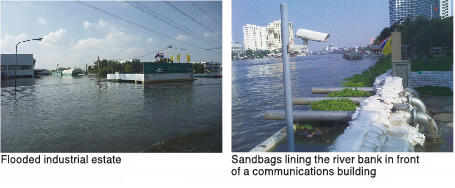
Severed submarine cables off the coast of Taiwan
The coast of Taiwan is susceptible to earthquakes, typhoons, and other natural disasters, and submarine cables off the coast have often been damaged in the past few years. To avoid such damage, NTT laid a new cable (ASE*) that detours this area.
*ASE : Asia Submarine-cable Express
